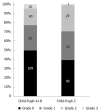Liver cirrhosis and left ventricle diastolic dysfunction: Systematic review
- PMID: 31528101
- PMCID: PMC6718042
- DOI: 10.3748/wjg.v25.i32.4779
Liver cirrhosis and left ventricle diastolic dysfunction: Systematic review
Abstract
Background: Liver cirrhosis is a chronic hepatic disease which is associated with cardiovascular abnormalities. Hyperdynamic circulation in liver cirrhosis causes functional and structural cardiac alterations. The prevalence of left ventricle diastolic dysfunction (LVDD) in cirrhotic patients ranges from 25.7% to as high as 81.4% as reported in different studies. In several studies the severity of diastolic dysfunction (DD) correlated with a degree of liver failure and the rate of dysfunction was higher in patients with decompensated cirrhosis compared with compensated. Future directions of comprehensive assessment of cardiac function in cirrhotic patients might provide a better prognosis for these patients.
Aim: To clarify the correlation between the severity of liver cirrhosis and left ventricle diastolic dysfunction in the existing literature.
Methods: Through January and February of 2019 at Vilnius University we conducted a systematic review of the global existing literature on the prevalence of left ventricle diastolic dysfunction in patients with liver cirrhosis. We searched for articles in PubMed, Medline and Web of science databases. Articles were selected by using adequate inclusion and exclusion criteria. Our interest was the outcome of likely correlation between the severity of cirrhosis [evaluated by Child-Pugh classes, Model For End-Stage Liver Disease (MELD) scores] and left ventricle diastolic dysfunction [classified according to American Society of Echocardiography (ASE) guidelines (2009, 2016)], as well as relative risk of dysfunction in cirrhotic patients. Subgroup analyses were performed to evaluate the ratio and grades of left ventricle diastolic dysfunction with respect to cirrhosis severity.
Results: A total of 1149 articles and abstracts met the initial search criteria. Sixteen articles which met the predefined eligibility criteria were included in the final analysis. Overall, 1067 patients (out of them 723 men) with liver cirrhosis were evaluated for left ventricle diastolic dysfunction. In our systemic analysis we have found that 51.2% of cirrhotic patients had left ventricle diastolic dysfunction diagnosed and the grade 1 was the most prevalent (59.2%, P < 0.001) among them, the grade 3 had been rarely diagnosed - only 5.1%. The data about the prevalence of diastolic dysfunction in cirrhotic patients depending on Child-Pugh Classes was available from 5 studies (365 patients overall) and only in 1 research diastolic dysfunction was found being associated with severity of liver cirrhosis (P < 0.005). We established that diastolic dysfunction was diagnosed in 44.6% of Child-Pugh A class patients, in 62% of Child B class and in 63.3% of Child C patients (P = 0.028). The proportion of patients with higher diastolic dysfunction grades increases in more severe cirrhosis presentation (P < 0.001). There was no difference between mean MELD scores in patients with and without diastolic dysfunction and in different diastolic dysfunction groups. In all studies diastolic dysfunction was more frequent in patients with ascites.
Conclusion: This systemic analysis suggests that left ventricle diastolic dysfunction is an attribute of liver cirrhosis which has not received sufficient attention from clinicians so far. Future suggestions of a comprehensive assessment of cardiac function in cirrhotic patients might provide a better prognosis for these patients and give hint for better understanding of the left ventricle diastolic dysfunction pathogenesis in liver cirrhosis.
Keywords: Correlation; Diastolic dysfunction; Echocardiography; Left ventricle; Liver cirrhosis; Systematic review.
Conflict of interest statement
Peer-review started: April 22, 2019
Figures



References
-
- Valeriano V, Funaro S, Lionetti R, Riggio O, Pulcinelli G, Fiore P, Masini A, De Castro S, Merli M. Modification of cardiac function in cirrhotic patients with and without ascites. Am J Gastroenterol. 2000;95:3200–3205. - PubMed
-
- Karasu Z, Mindikoğlu AL, Van Thiel DH. Cardiovascular problems in cirrhotic patients. Turk J Gastroenterol. 2004;15:126–132. - PubMed
-
- Lim YS, Kim WR. The global impact of hepatic fibrosis and end-stage liver disease. Clin Liver Dis. 2008;12:733–746, vii. - PubMed
-
- Ma Z, Lee SS. Cirrhotic cardiomyopathy: getting to the heart of the matter. Hepatology. 1996;24:451–459. - PubMed
Publication types
MeSH terms
LinkOut - more resources
Full Text Sources
Medical
Miscellaneous

